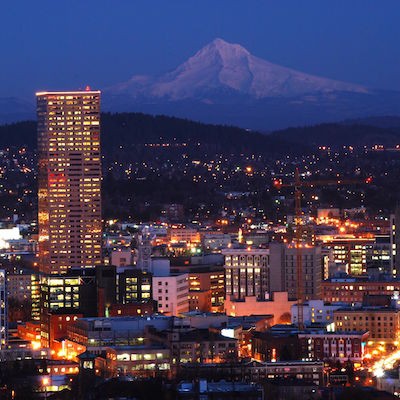Friday Financial Five – February 12, 2016





 Email to a friend
Permalink
Email to a friend
Permalink
Friday, February 12, 2016
Dan Forbes, GoLocalPDX Contributor
Rough start to 2016 has competing theories
The presidential election, a Chinese economic slowdown, spiraling oil prices, and interest rate concerns are all competing as the impetus for the global market swoon this year. It’s always impossible to pinpoint the exact cause, but suffice to say, investors haven’t shown a great deal of confidence in any sector, region, or company size thus far. The fear of an economic slowdown has Fed Chairwoman Janet Yellen talking about the legality of negative interest rates just months after a minimal rate hike last December.
President Obama’s budget proposes multiple changes
President Obama’s 2017 budget proposal tackles multinational companies and high income earners but also includes several components that will affect a wide range of earners. S-Corporations, which generate roughly half of business income, would face changes. The budget seeks to close the “backdoor Roth IRA” option where higher income earners make non-deductible IRA contributions and then convert them to Roth IRAs. The president would make Required Minimum Distributions a part of Roth IRAs while also disallowing contributions to those accounts after the age of 70 ½ and eliminating the “Stretch IRA”. Estimates for additional revenue from the proposal come to $2.6 trillion from 2017 to 2026.
Student loan debt more troublesome for women
A gap in pay between genders gets all the attention, but there seems to be less focus on what a gap means for retirement savings in the long term. A gap would also mean women have less income to repay school loans, and that’s happening according to a study by the American Association of University Women. Women take longer to pay back their loans leading to less time saving for retirement. For example, women who graduated in 2008 paid back 33 percent of their student loans by 2012, compared to 44 percent of debt being repaid by men.
Retirement confidence survey emphasizes need for planning
The Employee Benefit Research Company conducted a 2015 Retirement Confidence Survey. While nearly forty percent of all workers reported they wouldn’t have enough money to live comfortably in retirement, confidence was actually higher than in 2009. Data showed that workers and retirees spend less time doing retirement planning than they spend planning for the holidays. For example, 40 percent of workers spent eight or more hours planning for the holidays in the past year versus 34 percent of workers spending that amount of time planning for retirement. Nearly two-thirds of workers claimed they are still behind when it comes to planning and saving for retirement.
Sanders income tax plan
Following a decisive win in New Hampshire, Bernie Sanders’ tax plans may come under more scrutiny. The Tax Foundation’s analysis estimates almost $14 trillion in new tax revenue over the next decade. The taxes would include a 6.2 percent employer payroll tax increase and a 2.2 percent income tax on everyone. It would add four new tax brackets and push the highest bracket up to 54.2%, for those making $10,000,000 and more including capital gains and dividends. It also includes a tax on financial transactions.
Dan Forbes, a CFP Board Ambassador, is a regular contributor on financial issues. He leads the firm Forbes Financial Planning, Inc in East Greenwich, RI and can be reached at [email protected].
Related Slideshow: The 15 Biggest Business Stories of 2015

Prev
Next
#15
Oregon Approves Home Delivery of Marijuana
In October, the OregonLiquor Control Commission approved the final versions of the rules for full-scale marijuana retail sales that will begin next year. Home delivery of marijuana will be permitted under the new rules, but retailers can only deliver in the city in which they are licensed to operate, and can only transport $100 worth of marijuana at any one time. These are the final version regulations will take effect in January, and two drafts had been published earlier. Under the new rules, employees at licensed facilities who are medical marijuana patients will be allowed to consume cannabis at work, provided they are not intoxicated. Edible packaging must be prepared by the liquor commission. The rules also set guidelines for production limits for cannabis growers.
Read more.

Prev
Next
#14
Will Portland Be the Next San Francisco?
In the 1990’s San Francisco was cool, hip and so “not Los Angeles.” Today, it is big and expensive.The impact of the growth and increase cost of living has been profound, In the past three years, the median house price in San Francisco has increased from $665,000 to over $1.1 million, according to Paragon Real Estate Group. Could this be the fate of Portland?The impact of skyrocketing housing prices has has a big impact on San Francisco as the city is becoming only affordable to the wealthiest. “While high prices for real estate are bad news for most San Franciscans — only 14 percent of whom can afford the median price of for-sale homes in the city — the boom in local wealth is a boon for the city budget,” according to non-profit, SPUR.
Read More.

Prev
Next
#13
Thin Mints Shortage Threatens Regional Girl Scout Fundraising
In March, some Girl Scouts of Oregon and Southwest Washington(GSOSW) troops faced an impending cookie crisis. Some troops in the region ran out of Thin Mints, the historic number one-selling cookie, a staple of the organization’s principal fundraising campaign. “This is an unprecedented shortage of Thin Mints,” said Anne Rogge, Leader of Troop 45020, Harney Girl Scouts, Vancouver Girl Scouts. “There is growing concern.”Rogge said the shortage particularly impacts troops with "real little cookie movers," who will be unable to replenish their stocks. Troop 45020 will not have Thin Mints beyond the weekend unless another troop transfers them, she said. Leah Greenwood, the troop’s cookie coordinator, said after a series of frantic emails between parents and troop leaders, an emergency planning meeting has been scheduled for Sunday to develop a marketing strategy for less popular varieties of cookies. “How can we market Tagalongs and Trefoils?” Greenwood asked.
Read More.

Prev
Next
#12
KGW’s Reggie Aqui Leaving Portland for ABC San Francisco
In July, KGW-TV news anchor Reggie Aqui left Portland to join San Francisco ABC affiliate station KGO as an anchor and reporter. Aqui started out as a television reporter for WKYT-TV in Lexington Kentucky. In 2007 Aqui went to work for CNN where he covered President Obama’s inauguration, the Virginia Tech shootings, and interviewed Dolly Parton for online news reports. For the last few years Aqui has been a reporter for KGW and one of the anchors of its 4 pm newscast. He eventually took over hosting duties for the “Live at 7” broadcast.
Read More.

Prev
Next
#11
Home Buyers Flee Portland City Limits to Suburbs
As costs of living in Portland continue to increase, combined with a flat-lining vacancy rate, population growth has accelerated in other metro area cities – among them, Hillsboro and Beaverton in Washington County. With access to the MAX light rail and freeways, along with housing for a third of the cost, the suburbs are starting to look attractive to some who can’t afford Portland prices. Buyers’ agent Jolynne Ash says future homeowners are left with tough decisions to make. “If they can’t afford to buy in Portland, which is a big trend right now, they have no choice but to go outside of Portland. Or not buy at all,” said Ash. The competition is steep on the buyers’ market – and just when it will slow down is difficult to predict.
Read More.

Prev
Next
#10
Price Fluctuations Threaten to Drive Marijuana Growers Out of Business
A marijuana market saturated with product, falling prices and high taxes have put some Washington pot growers on the brink of closure, industry experts say. Marijuana growers and processors in the Evergreen state blame state regulators and an excise tax of 25 percent for what they say is a supplier-crushing bottleneck. Regulators failed to anticipate crop cycles or issue production and retail licenses cohesively, which led to a flooded market, roughly a dozen growers and retailers told GoLocalPDX. Put simply, there are more Washington growers with more marijuana than the market has demand for, and wholesale prices have dropped to a third of what they were when retailers opened their doors in July.
Read More.

Prev
Next
#9
Oregon’s 20 Best Jobs That Don’t Require A College Degree
A lot of jobs that don’t require a four-year college degree pay better than you might think: a firefighter in Oregon has a higher hourly wage than an accountant, while an electrician can make more than a wildlife biologist, according to analysis by the Oregon Employment Department. Jobs that require technical education, apprenticeships, on the job training, or even no training at all make an average of 24 dollars per hour in Oregon. Some positions can average over 35 dollars an hour and 67,000 dollars a year.
Read More.

Prev
Next
#8
Will Growth Kill Portland?
Many Portlanders caught wind of the study released by Governing Magazine last month: Portland is the fastest gentrifying city in America, with “58 percent of Portland’s lower-priced neighborhoods gentrified since 2000,” it reported. While growth creates jobs and prosperity for some, others will undoubtedly get left behind. And Portland’s rapid expansion could make it the urban center it fought hard to separate itself from. With a population of 601,510 people, around 9,400 persons moved to the city between 2013 and 2014, more than double the number in the previous year. In five years, Portland’s population would reach between 630,000 and 650,000, according to statistics provided by the Population Research Center at Portland State University. A strengthening economy could be a reason. But young people keep moving here, with or without a job.
Read More

Prev
Next
#7
The Highest Paid CEO's in Oregon
The average Chief Executive Officer made 91 times the average worker's salary in Oregon in 2013, according to a study, “Executive Paywatch: High Paid CEOs and the Low Wage Economy”, published by the American Federation of Labor and Congress of Industrial Organizations (AFL-CIO). According to the Bureau of Labor Statistics data for production and nonsupervisory workers, the average worker in Oregon made $39,464 a year in 2013, while the average CEO in Oregon, according to the AFL-CIO, was paid $3,587,770. Nationally, the CEO to worker pay ratio in 2013 was 331 to 1, and the CEO to minimum wage worker ratio was 771 to 1.
Read More

Prev
Next
#6
Portland’s 20 Hottest Neighborhoods for Real Estate
Over half of Portland’s hottest real estate neighborhoods are near or east of 82nd Street, according to data pulled from the real estate brokerage Redfin. Portland’s real estate market for sellers is probably the hottest it has ever been, especially for the east side of the city. Of neighborhoods that sold the most home over the last 90 days, the top five are located in East Portland. Over 80 homes were sold in the Brentwood-Darlington area, the highest of any neighborhood. Historically low property values have kept home prices in East Portland comparatively cheap compared to other parts of the city. Meanwhile, a shortage of available single family homes makes property on the eastside in high demand. Low inventory and high prices are driving the real estate market in all of Portland, according to Jan Caplener one of the owners of Portland’s Reality Trust.
Read More

Prev
Next
#5
Portland’s Tech Industry Could Grow Under Obama Program
The Portland metro area is among 21 regions in the nation to join President Obama’s TechHire – a multi-sector initiative that aims to train and connect Americans to jobs in information technology (IT). The initiative is part of the President’s agenda to strength middle-class America through education and training for high demand and high wage jobs.Taking the reins in Portland is the online training program, Code Oregon. Initiated and funded by Worksystems, the local Workforce Development Board, with support from the State of Oregon, Code Oregon aims at teaching 10,000 Oregonians how to code and find high paying careers in fields such as software and web development, as well as app design.
Read More

Prev
Next
#4
Why Most OR Employers Will Keep Zero Tolerance Marijuana Policies
Zero tolerance drug policies in the workplace can still snare an employee having a brownie over the weekend despite Oregon’s lifted prohibition on recreational marijuana, which went into effect on July 1. That’s because federal laws still complicate things legally. Furthermore, drug tests currently available for marijuana can detect the metabolite from THC from the brownie you ate at a weekend party when you’re pulled for an at-random drug test at work. While not all employers want to squabble about your weekend, they also can’t tell the difference between on- or off-work use. Because of these uncertainties, “most employers are not changing their policies and are sticking with zero tolerance,” said Ryan Orr, an HR and compliance consultant for the Cascade Employers Association who has been working with employers on this issue. “Employers still don’t have any obligation to allow exceptions to drug testing policy for marijuana because it’s still illegal federally.”
Read More

Prev
Next
#3
Blame for Oregon Forest Fires Falls on Feds, Says Logging Industry
Oregon is in the midst of its third consecutive summer of severe forest fires, and industry professionals say logging limits on federal land are largely to blame. The fires have already made their costs felt, as the Oregon Department of Forestry has already spent an estimated $25 million to date on this year’s blazes. This comes on the heels of two consecutive severe seasons in 2013 and 2014, the former of which was the most destructive wildfire season in the state’s history. Executives and professionals within the logging industry told GoLocal on Thursday that limits on logging in National Forests and other federally owned lands are making conditions perfect for large-scale fires. Oregon does not have a similar ban on state-owned lands.
Read More

Prev
Next
#2
Unions Battle with KGW Owner Tegna Over New Contract
Labor unions are claiming KGW owner Tegna, a Gannett spinoff, is looking to bust up the network’s unions in order to replace union workers with cheaper help or prepare for a sale -- and that they are currently fighting for their lives against the newest owner of the local news station. Gannett owned KGW when many of these labor disputes began, but the company was split into two companies in June of this year. KGW is now owned by Tegna. In bargaining with the station's four unions, Tegna is pushing to get rid of the clause on union jurisdiction. This would mean that Tegna, who owns and operates KGW, would be able to fire employees who were hired as union members and replace them with non-union employees, who make far less than their union counterparts.

Prev
Next
#1
Surprising Takeaways About Portland’s Booming Growth
Nearly 10,000 people have moved to Portland between 2013 and 2014, according to the Population Research Center at Portland State University. In five years the population of the city could reach 650,000, up from the current population of almost 610,000. The city is growing, and that’s not surprising. Once you break the numbers down, though, some surprising facts emerge. Portland’s residents pride themselves on their welcoming nature. However, Portland is experiencing extensive gentrification according to a study from governing.com. In fact, more than 58% of its eligible tracts are gentrified, which is more than any other city reviewed in the study.
Read More
Related Articles
- Friday Financial Five – March 20th, 2015
- Friday Financial Five – March 27th, 2015
- Friday Financial Five – March 6th, 2015
- Friday Financial Five – May 29th, 2015
- Friday Financial Five – March 13th, 2015
- Friday Financial Five – June 5th, 2015
- Friday Financial Five – July 31, 2015
- Friday Financial Five – July 3rd, 2015
- Friday Financial Five – June 12, 2015
- Friday Financial Five – June 19th, 2015
- Friday Financial Five – November 13th, 2015
- Friday Financial Five – November 14th, 2014
- Friday Financial Five – October 30, 2015
- Friday Financial Five – October 9, 2015
- Friday Financial Five – September 18th, 2015
- Friday Financial Five- November 7th, 2014
- Friday Financial Five – October 23, 2015
- Friday Financial Five – October 2, 2015
- Friday Financial Five – November 20th, 2015
- Friday Financial Five – November 21st, 2014
- Friday Financial Five – November 28th, 2014
- Friday Financial Five – November 6, 2015
- Friday Financial Five – July 24, 2015
- Friday Financial Five – July 17, 2015
- Friday Financial Five – December 12th, 2014
- Friday Financial Five – December 18th, 2015
- Friday Financial Five – December 5th, 2014
- Friday Financial Five – February 13th, 2015
- Friday Financial Five – August 7th, 2015
- Friday Financial Five – April 3rd, 2015
- Friday Financial Five - August 14th, 2015
- Friday Financial Five - August 21, 2015
- Friday Financial Five - September 24th, 2015
- Friday Financial Five – April 17th, 2015
- Friday Financial Five – February 20th, 2015
- Friday Financial Five – February 27th, 2015
- Friday Financial Five – January 29, 2016
- Friday Financial Five – January 30th, 2015
- Friday Financial Five – January 8, 2016
- Friday Financial Five – July 10th, 2015
- Friday Financial Five – January 23rd, 2015
- Friday Financial Five – January 2, 2015
- Friday Financial Five – February 5, 2016
- Friday Financial Five – February 6th, 2015
- Friday Financial Five – January 16th, 2015
- Friday Financial Five
Enjoy this post? Share it with others.





 Email to a friend
Permalink
Email to a friend
Permalink



































 Delivered Free Every
Delivered Free Every
Follow us on Pinterest Google + Facebook Twitter See It Read It